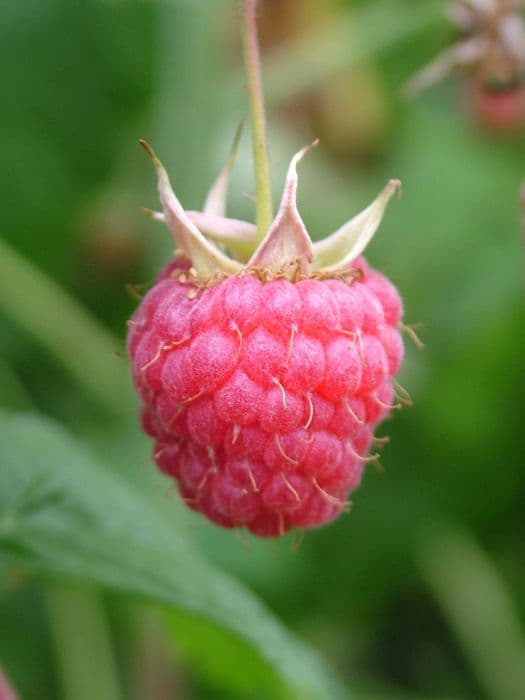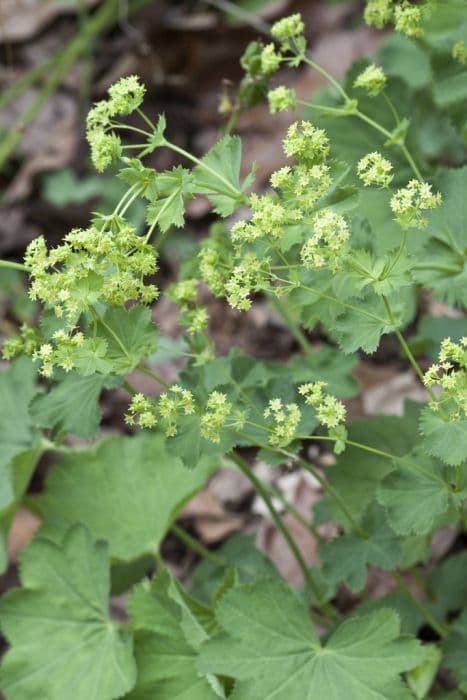Raspberry Rubus idaeus 'Glen Magna' (PBR) (F)

ABOUT
The plant commonly known as 'Glen Magna' raspberry features numerous canes that sprout from its base, creating a bushy and vigorous growth habit. Its canes are typically covered in small thorns that can catch onto clothing or skin. These canes bear pinnately compound leaves which are made up of several smaller leaflets that are deep green in color, with a slightly pale underside and have serrated edges, giving them a textured appearance. During the flowering period, 'Glen Magna' produces clusters of white, five-petaled flowers which are notable for their delicate appearance and are attractive to pollinators such as bees. Following the flowering stage, the plant begins to set fruit. The raspberries themselves are typically large and conical, starting out as pale green and gradually maturing to a deep, rich red color that signifies ripeness. The berries are known for their delectable sweet flavor with a hint of tartness, making them a popular choice for fresh eating, jams, and desserts. The surface of the fruit is slightly hairy with a soft, slightly plush consistency when ripe, and they detach easily from the plant when they are ready to be harvested. In addition, the 'Glen Magna' raspberry plant is deciduous, meaning it will shed its leaves in autumn, revealing the somewhat arching framework of its canes which turn woody over time, providing a slightly rugged look to the garden even in the non-growing season. Overall, the 'Glen Magna' adds both aesthetic appeal and practical fruit production to any garden setting.
About this plant
 Names
NamesSynonyms
Glen Magna Raspberry, Glen Magna Red Raspberry.
Common names
Rubus idaeus 'Glen Magna'.
 Toxicity
ToxicityTo humans
Raspberry 'Glen Magna' is not known to be toxic to humans. In fact, raspberries are commonly eaten and are known for their nutritional benefits.
To pets
Raspberry 'Glen Magna' is not considered toxic to pets. Raspberries can be given to pets like dogs in moderation as a treat, but it's always best to consult with a veterinarian before introducing new foods into their diet.
 Characteristics
CharacteristicsLife cycle
Perennials
Foliage type
Deciduous
Color of leaves
Green
Flower color
White
Height
5 feet (1.5 meters)
Spread
2 feet 6 inches (0.76 meters)
Plant type
Shrub
Hardiness zones
4
Native area
Europe
Benefits
 General Benefits
General Benefits- Nutritious Fruits: Raspberry plants produce berries that are high in vitamins, antioxidants, and fiber.
- Attractive to Pollinators: Flowers provide a food source for bees and other pollinating insects, which is beneficial for garden biodiversity.
- Enhanced Landscape Aesthetics: The plant adds visual interest to gardens with its attractive berries and foliage.
- Erosion Control: The dense growth habit of raspberry plants can help prevent soil erosion.
- Wildlife Habitat: Provides shelter and food for various wildlife, including birds and small mammals.
- Edible Landscaping: Can be incorporated into garden designs that prioritize both aesthetics and functionality.
 Medical Properties
Medical Properties- Antioxidant: Raspberry fruit and leaves contain vitamins and phenolic compounds that may have antioxidant properties.
- Anti-inflammatory: Compounds in raspberries may have anti-inflammatory effects.
- Gastrointestinal aid: Raspberry leaf tea has traditionally been used to soothe gastrointestinal tract disorders.
- Menstrual relief: Raspberry leaf is sometimes used to relieve symptoms associated with menstruation and childbirth.
 Air-purifying Qualities
Air-purifying QualitiesThis plant is not specifically known for air purifying qualities.
 Other Uses
Other Uses- Natural dye: The berries of the raspberry plant can be used to create a natural red or pink dye for fabrics, yarns, or even in cosmetics.
- Fruit leather: Pureed raspberries can be dried into sheets to make fruit leathers, a healthy snack option.
- Educational tool: Raspberry plants can be used in school gardens to teach children about plant biology, pollination, and fruit development.
- Aromatherapy: The fragrance of the raspberry plant's leaves and fruit can be used to create essential oils for aromatherapy purposes.
- Textile printing: Raspberry juice or extracts can be used in textile printing to contribute color and patterns on natural fabrics.
- Crafts: Dried raspberry canes can be woven into baskets, mats, or even used as natural supports for other plants.
- Photography: The vibrant colors and textures of raspberry plants, including 'Glen Magna', provide excellent subjects for botanical photography.
- Erosion control: Raspberry plants have extensive root systems that can help to stabilize soil and prevent erosion on slopes or banks.
- Insect repellent: Crushed raspberry leaves can sometimes repel certain insects, and could be explored as a natural pest control method.
- Wildlife habitat: Raspberry plants can offer shelter and food for a variety of wildlife, such as birds and beneficial insects.
Interesting Facts
 Feng Shui
Feng ShuiThe Raspberry is not used in Feng Shui practice.
 Zodiac Sign Compitability
Zodiac Sign CompitabilityThe Raspberry is not used in astrology practice.
 Plant Symbolism
Plant Symbolism- Protection: The raspberry plant, to which Rubus idaeus 'Glen Magna' belongs, has thorny branches which can symbolize protection and the idea of setting boundaries or safeguarding something treasured.
- Kindness: Raspberries can symbolize kindness due to their association with sweetness and nurturing, which are qualities often related to considerate and gentle behavior.
- Fertility: The abundance of fruit produced by the raspberry plant stands as a symbol of fertility and productivity in both the literal and metaphorical sense.
- Innocence: The delicate nature and the pure, rich color of raspberries are sometimes used to denote purity or innocence.
- Pleasure: The sweet taste of raspberries makes them a symbol of pleasure and enjoyment, hinting at life's sweetness and small delights.
 Water
WaterRaspberry 'Glen Magna' plants prefer consistent moisture, especially during fruiting periods. Water these plants with about 1 to 1.5 inches of water per week, and make sure to soak the soil thoroughly. During hot, dry spells, you may need to water twice a week to maintain sufficient moisture levels. Use a soaker hose or drip irrigation to apply water directly to the base of the plants, avoiding wetting the foliage, which can promote disease. During the fall and winter, reduce watering as the plant’s growth slows down and the weather provides natural precipitation.
 Light
LightRaspberry 'Glen Magna' thrives in full sun, meaning it requires a minimum of six hours of direct sunlight daily. The best spot for planting would be in a location that receives morning sun and some afternoon shade, especially in hotter climates, to protect from intense heat. Avoid heavily shaded areas, as this will reduce fruit production and can encourage fungal diseases.
 Temperature
TemperatureRaspberry 'Glen Magna' grows best in temperatures between 55°F and 75°F but can tolerate a range from around 28°F to 85°F. Frost can damage the canes and flowers, so provide protective cover if temperatures are expected to drop below freezing. In high summer temperatures, be sure to provide adequate water to prevent heat stress.
 Pruning
PruningPruning Raspberry 'Glen Magna' is essential to maintain plant health and maximize fruit production. Remove all weak, damaged, or diseased canes in the late winter or early spring. After fruiting, prune out the canes that have produced berries, as they will not produce again. Annually thin the canes, leaving the strongest and most vigorous ones about 6 inches apart.
 Cleaning
CleaningAs needed
 Soil
SoilRaspberry 'Glen Magna' thrives best in well-drained, loamy soil enriched with organic matter. The ideal pH level for this raspberry variety is between 5.5 and 6.5. For optimal growth, a mixture of garden soil, compost, and aged manure will create a fertile environment.
 Repotting
RepottingRaspberry 'Glen Magna' is typically not repotted as it is a perennial shrub; instead, it should be planted outdoors with room to spread. Dividing can be done every few years to maintain vigor.
 Humidity & Misting
Humidity & MistingRaspberry 'Glen Magna' is adaptable to average outdoor humidity levels and does not require specific humidity conditions for successful growth.
 Suitable locations
Suitable locationsIndoor
Not ideal to grow indoors; needs sun and space.
Outdoor
Plant in sun, well-drained soil, space canes 18 in. apart.
Hardiness zone
4-8 USDA
 Life cycle
Life cycleRubus idaeus, commonly known as the raspberry 'Glen Magna', begins its life cycle when seeds germinate in the spring, typically requiring stratification to break dormancy. The seedlings develop into first-year canes, or primocanes, that grow vegetatively throughout the summer, establishing a root system and foliage but not producing fruit. In the second year, these primocanes grow and become floricane, which will bear fruit in early to mid-summer. After fruiting, the floricane dies back while new primocanes develop, ensuring the perennial cycle of the plant. The raspberry 'Glen Magna' can also spread through vegetative means with new shoots rising from its root system, creating a clonal colony. After several years, the plant may need rejuvenation or may be replaced as fruit production declines with age.
 Propogation
PropogationPropogation time
Early Spring
Propogation: Rubus idaeus 'Glen Magna', commonly known as red raspberry, is most effectively propagated through the division of root cuttings taken during the dormant season, typically between late fall and early spring. To propagate, one should carefully dig up healthy canes and sever a section of root approximately 4 to 6 inches (10 to 15 centimeters) in length. This root section should contain at least one bud or eye. The root cuttings are then planted horizontally in well-drained, fertile soil at a depth of around 2 inches (5 centimeters), making sure that the bud is facing upwards. The soil should be kept moist but not waterlogged to encourage root development, and within a few weeks, new shoots should appear as the cutting establishes. This method is favored due to its simplicity and the high success rate in producing new plants that are true to the parent variety.









